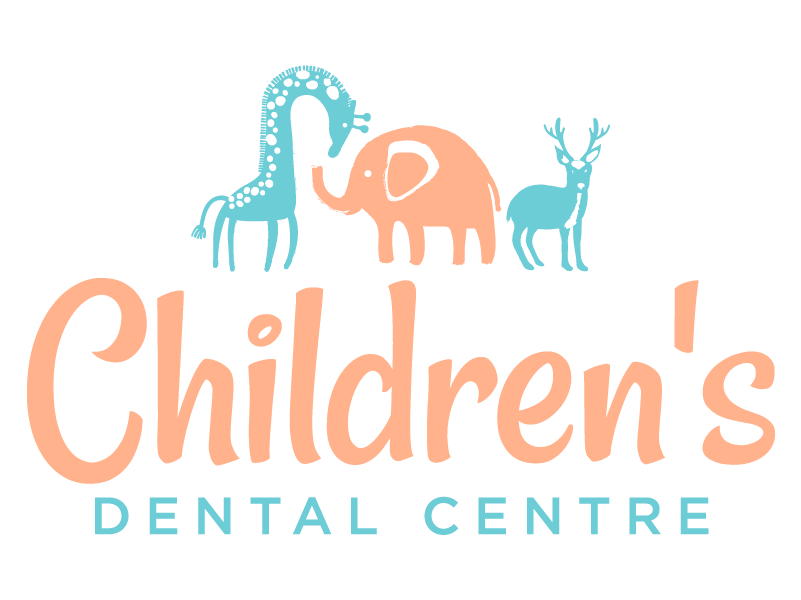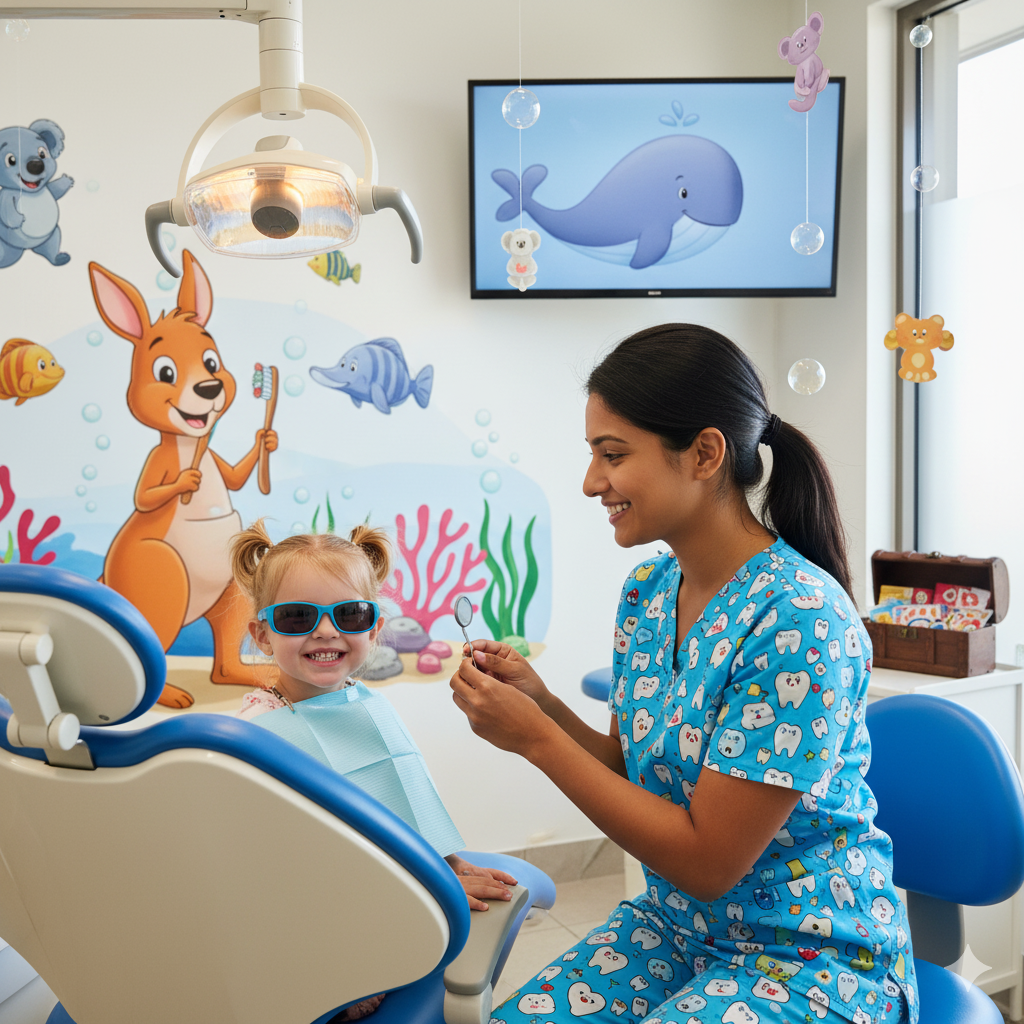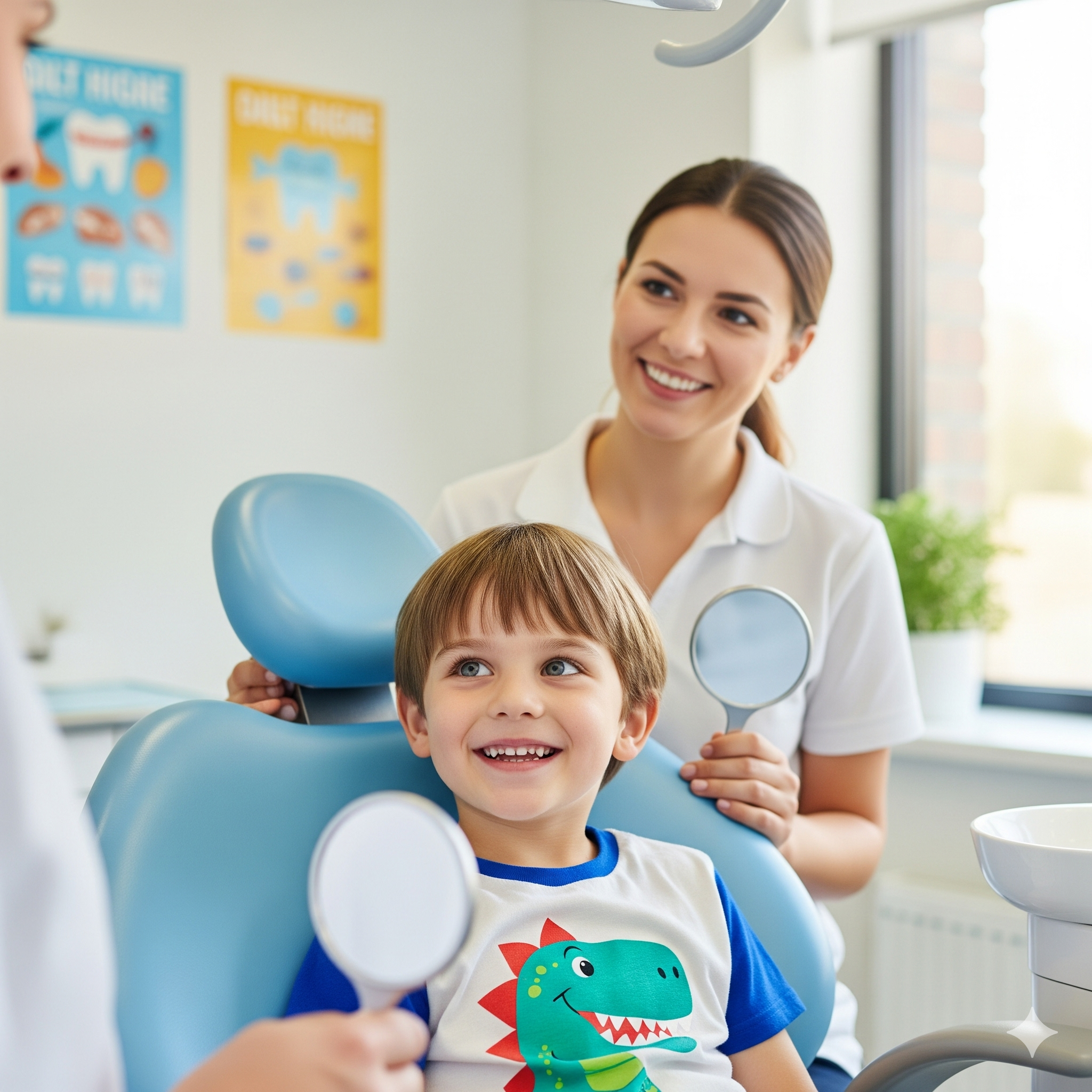How a Child Friendly Dentis Can help with Dental Anxiety in Children?
The eruption of your child’s first tooth is the perfect time to start creating positive dental habits. Did you know that about 1in 4 children experience dental anxiety? So, how can dental anxiety in children be minimized so that they feel safe during dental visits? With the help of child friendly dentists who use evidence-based techniques. Techniques may include tell-show-do-explanations, desensitization, playful décor and other interactive elements to name just a few.
Here are seven science-backed, anxiety minimizing strategies that dentists use, clear answers to common parental/caregiverquestions about baby teeth, and what to expect for your child’s first visit to the Children’s Dental Centre in North Brisbane.
Quick Summary
The blog explores how child friendly dentists can help reduce dental anxiety in children using child-friendly techniques such as tell-show-do, sensory-aware clinic design and when clinically indicated, the use of carefully monitored nitrous-oxide sedation. It also introduces Children’s Dental Centre in North Brisbane, where staff are trained in child communication and behavior guidance aiming to make treatment more comfortable for young patients
What are Common Reasons for Dental Anxiety in Children?
Some of the main factors for dental anxiety in children include:
Previous discomfort or pain: This could be related to a negative prior dental experience which can unfortunately leave a lasting memory of fear in the children. Dental pain, such as a sore tooth can also cause anxiety.
Sensory overload: Loud sounds, bright lights,and unusual tastes and smells that the child is not used to, as well as the feeling of the instruments in the mouth can overwhelm some children.
Parental/caregiver influence: Children often sense dental worries of a parent/caregiver through their words or the body language that they show. Children often tend to absorb that anxiety. How? By simply observing the gestures and the conversation between parents and the doctors.
Fear of the unknown: Children may have a limited understanding of what will happen. This may lead to children worrying and imagining what may happen.
Perceived Loss of control: Being reclined in a dental chair and having an unknown person examine the mouth can lead to children feeling that they don’t have any control of the situation.
How Widespread Is Dental Anxiety in Children?
A global analysis of 50 studies in 2021 reported that approximately 24% of children between the ages of 3 and 18 exhibited significant dental anxiety. Anxiety rates of children were the highest in the preschoolers at around 36.5%. These then reduced to approximately 13.3% in adolescents.
What Is a Child Friendly Paediatric Dentist?
A child-friendly paediatric dentist is a practitioner who has completed additional specialist paediatric training and gained additional experience by treating infants, children and teenagers. In Australia a specialist paediatric degree takes an additional three years of study. The training involves learning and understanding specific behaviour management techniques and understanding child development. The use of age-appropriate language and behavior-guidance techniques help make dental appointments more comfortable and preventive dental care for your child can be more enjoyable.
How are Paediatric Dentists Different from General Dentists?
With additional paediatric training and a child-centered clinic design, the team aim to make dental appointments, including the first dental visit more comfortable. A positive first visit can also help encourage good oral-health habits from an early age.
7 Ways Child Friendly Dentists Can Help Reduce Anxiety in Kids
Tell-Show-Do Communication with Children
The dentist will explain what will happen during the dental checkup/treatment in simple words. After this, they will show the instrument or the process that they will do in brief. Only after this, they will carry out the actual dental checkup
process.A step-wise approach such as this can make the procedure feelmore predictable and may lower anxiety. In fact, research suggests that regular use of tell-show-do techniques can help lower anxiety levels in children.Playful, Sensory-aware Dental Clinic Design
Waiting rooms and clinics are often designed with child in mind. These may include child appropriate décor, toys and books. This can help to distract and keep a child entertained whilst waiting for their appointment. During the appointment, we can also make the environment as calm as possible by things such as dimming the lights, playing music or even watching a familiar show on our roof televisions. First contact is also important, so dentist aims to greet the child in a non-threatening warm way.
Parental Involvement & Education
When a parent or a caregiver stays with the child beside them, their familiar presence can provide comfort. In addition to this, it supports building rapport between the child and the dentist. We can examine a child in many ways to make them feel most at ease;- on the clinic chair, lying on a parent, or even a knee-to-knee exam.
Dentists may also provide some guidance to parents by suggesting positive dental language and even role-playing at home. Dentists can help with advising parents on how to discuss dental visits with the child prior to attending. These can make future dental appointments feel more familiar and
less stressful for many children.Behaviour-Guidance Techniques
Positive reinforcement: Praise, stickers, or small rewards that will help the child link cooperative behavior with a positive experience.
Gradual desensitisation: Simple step by step visits that start with simple tasks can help overcome worries. Relaxation exercises such as “balloon breathing”, may also help children manage their stress. This may help even during longer procedures and usually reduces discomfort in the child.
Distraction: Child friendly dentists can divert children’s attention from a potentially stress inducing procedure to a tollay different sensation or action.
Positive reinforcement: This can help create success and encourage desired outcomes.
Pain-Free Technology
Technology in dentistry is continually improving. There are many technologies continually becoming available to help make dentist more pain free. These can help children feel more comfortable.When cavities are detected in a child early, dentists may use minimally invasive techniques which often do not require local anaesthetic or drilling.
Nitrous-Oxide Sedation (Happy Gas Dental Treatment)
Nitrous oxide dental treatment involves breathing a combination of oxygen and nitrous oxide that produces mild, short-acting relaxation while the child remains awake and is able to respond to the dentist. It is particularly useful to make the first dental treatment appointment a positive one.
This form of minimal sedation can make longer or more complex procedures such as treating a tooth abscess or trauma in a child, more manageable.
In other children, other pharmacological techniques may be needed, such as general anaesthesia, where your child is asleep for dental treatment. The team at Childrens Dental Centre can also offer this if appropriate.Adaptations for Children with Additional Needs
Appointments can be booked at quieter times. A pre-appointment visit to the clinic may be useful for some children.A social story can be provided to help prepare children prior to the first visit. Dentists are also able to be guided by the parent/caregiver on best managing their children; whether
it be the use of a weighted blanket, dimmed lights, or using clear simple language. Dentists also consider their approach depending on the childs stage of development and temperament. Often, the more experience with children a dentist has, the more they can develop the skills to best manage children.
How Children’s Dental Centre in North Brisbane Helps Minimize Dental Anxiety for Your Kids?
Children’s Dental Centre (CDC) was founded by Dr. Tim and Dr. Sarah in the Sunshine Coast. Since then, with the additional of Dr Jacqui and Dr Caitlin (along with an amazing team of other dentists, oral health therapists and support staff), it has expanded to Hervey Bay, as well as North Brisbane. The clinics have been designed specifically for paediatric dental care. The practice aims to provide accessible dental care for infants,children and the teenagers. This allows many families in the area to obtain treatment closer to their resident locations for dental trauma, dental caries, dental anomalies or other dental-related issues for their children.
What does Children’s Dental Centre (CDC) Offer?
Infant oral examinations: We generally recommend a first dental visit within six months of the first tooth erupting, or by one year of age. This is in line with the Australian Dental Association guidance. In fact, early visits may help identify emerging issues like enamel defects, tooth decay and tooth ache in children before they become more complex or uncomfortable. Eligible families may be able to claim rebates for certain services under Australian Government’s Child Dental Benefit Scheme (CDBS).
Experience with Special Needs Children: Dentists at CDC have completed training in the care of patients with special needs such as autism, ADHD and other complex medical conditions. The team tailors lighting, noise levels and appointment timing to suit each child’s sensory preferences, thereby trying to reduce dental anxiety for children in Brisbane and the Sunshine Coast.
General anaesthesia - For toddlers, children or teenagers who cannot tolerate in-chair care, the clinic can arrange treatment under general anaesthesia with a registered specialist anaesthetist. Such options can make access to the required dental care more convenient and comfortable for some families.
What to Expect at the First Dental Visit in North Brisbane?
Prior to the visit: We will provide you with information before the visit, and often collect some information to help plan the first visit. The team always welcomes any information about your child that you think may be helpful.
Warm welcome: Staff will greet you and your child in a child friendly waiting area with age-appropriate toys, colouring and books that can help keep them occupied before the appointment.
Introduction: Our dentist says hello and lets the child explore before the examination starts. Any concerns you have will be discussed and questions answered.
Tell-show-do: The child friendly dentist will explain what will happen, shows each of the instruments that will be used and then gently counts the teeth and examines the mouth (which includes the teeth, gums, tongue and airway). This process may vary from one child to another depending on what works best for them.
Parent discussion: You stay with your child, throughout the appointment, while the dentist may talk about brushing habits, diet, fluoride use and recommended recall intervals, or anything else specific to your child.
Positive ending: A sticker or a small toy may be offered to acknowledge your child’s cooperation. This usually encourages confidence in the child so that they will get familiarized with pain free and positive dental visits.
Conclusion
Choosing a child friendly dentist who focuses on treating toddlers, children and teenagers can provide benefits beyond just reducing anxiety. Positive dental experiences at an early age may help children see routine check-ups as a normal part of staying healthy.
Regular dental examinations which start in infancy allow dentists to detect small problems early – often before discomfort develops and whilst treatment options may be more simple, straightforward and less costly.
A calm environment may also encourage children to ask questions and feel confident and empowered about caring for their teeth.
Additionally, parents receive guidance on age-appropriate brushing, toothpaste use, diet and prevention that they do at home. Working together in this way can support good oral- health habits and confidence that extends into adulthood.
If you are searching for a dental clinic in North Brisbane, whether it be for a first dental visit, or subsequent visit, then we’d love you to give Children's Dental Centre a call. We will be more than happy to assist you.
Frequently Asked Questions (FAQs)
1) When should my child first see a dentist?
Most Australian oral-health bodies advise scheduling a child’s first dental visit within six months of the first tooth erupting, and no later than the first birthday. This early appointment allows dentists to monitor the development and eruption of teeth, provide tailored preventive advice and identify issues (such as early-childhood caries, an aggressive form of tooth decay) early, before they become more serious.
2) How can paediatric dentists support children with special needs like autism?
Dentists experienced in treating children with special needs like autism may offer quieter appointment times, dimmer lighting, weighted blankets or noise-reducing headphones. Additionally, they can break procedures into short, predictable steps with visual schedules. They will work with you and your child to encourage positive and successful visits.
3) What if my child finds it hard to sit still?
This is extremely common. Dentists who treat children often have many behavior-guidance strategies that can help, such as positive reinforcement, distraction, short “practice rides” in the chair and, for toddlers – parent-lap examinations. When cooperation is still difficult, additional options may include minimal-sedation with nitrous oxide or in some cases, treatment under general anaesthesia with a registered specialist anaesthetist.
4) How can I help my child get ready for the dental visit?
Try reading positive storybooks, practice “open wide” and ‘counting teeth’ exercises at home (just like a dentist does), use child friendly language (no threats), and try to book morning appointments when your child is rested. Bringing a favourite toy and maintaining a calm, positive manner can help your child see dental visits as a normal part of staying healthy.





